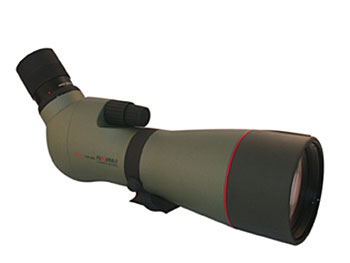
Spotting scopes are used by birders to take advantage of their powerful magnification capabilities. Spotting scopes generally operate in a range of 20x to 60X magnification. At 60x, an object looks 60 times closer than it does with the naked eye.
Viewing angle
There are two basic designs for the viewing angle. There is no difference in the quality of image and the final choice is one of personal preference.

This eyepiece is at a 45 deg. angle to the barrel of the spotting scope. When mounted on a tripod, this design allows the tripod to be at a lower position, providing a more stable platform. Image from Kowa Optimed, Inc.
Magnification
The amount of magnification is based on the eyepiece. The range is usually from 20x up to 60x. In general, the higher the magnification, the lower the image quality.
Replaceable eyepieces
Some scopes are designed with replaceable eyepieces. A user may have a 20x, a 30x and a 40x eyepiece. The eyepieces are changed based on the viewing conditions.
The individual eyepieces can be expensive.
Alert: Spotting scopes can be sold without an eyepiece. When purchasing, make sure the eyepiece is included with the purchase.
Zoom eyepiece
Some spotting scopes come with a zoom eyepiece, often in the range of 20x to 60x.
Some birders feel the fixed magnification eyepieces provide a slightly better image than a zoom eyepiece. Others prefer the convenience of the zoom.
If you are purchasing a top-of-the-line spotting scope from companies like Zeiss, Swarovski and Kowa, zoom eyepieces will deliver excellent image quality. Prices range from about $1500 to $2000 for these high-end units.
If you are considering a lower cost unit (as many of us do) with a zoom lens, try to test the unit before purchase to make sure the image quality is acceptable to you.
Eyeglass wearers – be sure to determine that the eyepiece selected is ‘eyeglass friendly.’ There are several designs available, including some very poor ones.
Light gathering
The brightness of the image is based on several factors, including the type of glass used in the lenses, lens coatings and diameter of the objective lens (the front end of the scope).
Unless you have a Phd in optics, all the special names used to describe the type of glass and coatings used by the different manufacturers is really of little value. Great marketing, but very few have the knowledge to really judge the difference between one type of lens coating and another.
The diameter of the objective lens is something we can all judge. The larger the objective lens, the brighter the image. Objective lenses are measured by their diameter in mm. The range runs from about 50 mm to almost 90 mm in a typical spotting scope used for birding.
The downsides to the larger diameter lenses are increased cost, size and weight.
Eye relief
The eye relief is the distance a spotting scope can be held away from the eye and still provide a full field of view. In general, the longer the better, especially for eyeglass wearers.
Nitrogen purging
A good spotting scope will have a rugged design and be tightly sealed. Better quality units are purged with an inert gas, then sealed to prevent moisture from building up on the inside lens surfaces.
Making the final choice
If your interest in birding has reached the point that you are interested in a spotting scope, we recommend that you keep saving until you can purchase a top-of-the-line spotting scope. The gap between a top-of-the-line and mid-level spotting scope is much greater than the difference in a top-level and mid-level binocular. You can expect to use a top quality spotting scope for 20 years or more, so the long-term cost of ownership is not out of line.
Spotting scopes also require tripods for use. Tripods can be expensive, so be sure to include the price of a tripod in your budget plans. Visit the tripod section for additional information.

